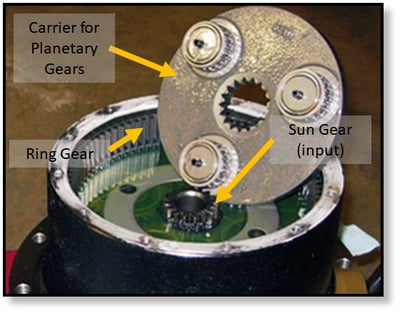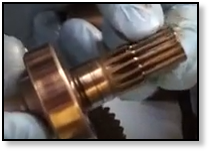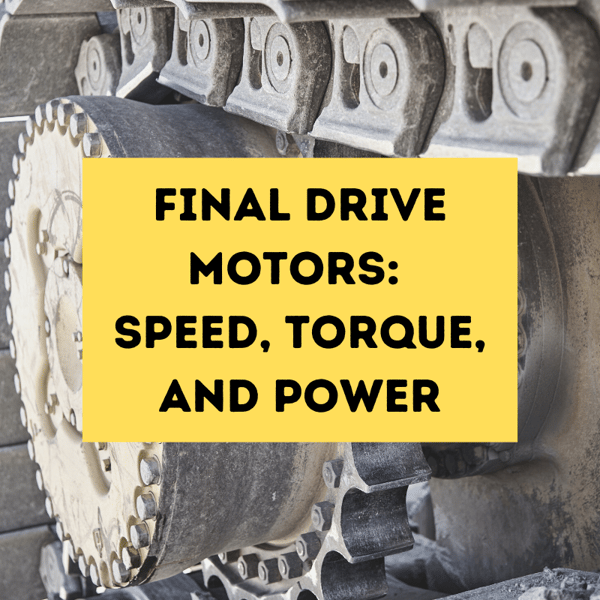One of the most important relationships for final drive motors ties together power, torque, and speed -- and understanding this relationship can help you troubleshoot your final drive motor.
Here are a few other blog posts you might find helpful:
- 5 Reasons a Final Drive Can Lack Power
- Torque, Traction, and Horsepower
- 3 Critical Questions About Single-Speed and Dual-Speed Final Drives
Speed, Power, Torque Relationship
There is a relationship between speed, torque, and power that applies to both electric and hydraulic motors:
POWER = TORQUE X SPEED
We can manipulate these equations to see how speed and torque are related:
SPEED = POWER / TORQUE
TORQUE = POWER / SPEED
For two hydraulic motors that generate the same amount of power, the following is true:
- Increasing the torque reduces the speed
- Increasing the speed reduces the torque
We need to reduce the speed to generate more torque using the same power. A hydraulic motor running at low speed can generate more torque than at high speed. And to have a motor run at higher speed, the torque it generates must be reduced. And for that reason, many hydraulic motors are classified as HSLT or LSHT.
HSLT motors run at high speeds ( typically from 1,000 to 5,000 rpm) and generate low torque. LSHT motos, on the other hand, have slower speeds (ranging from 0.1 to 1,000 rpm) and generate the torque needed to handle heavy loads.

To achieve higher torque, some hydraulic motors will have a speed-reducing system. The planetary gear set on many final drive motors is a perfect example. The gearing system is designed to multiply the torque output by reducing the speed input from the hydraulic motor.
Calculations
First, we need to talk about unit conversions to use the POWER = SPEED x TORQUE relationship correctly. We’ll focus on English units.
Rpm needs to be converted to compatible units of rad/min. We know that one revolution per minute equals 2π radians per minute, also expressed simply as 2π per minute. Here’s how we get the conversion factor:
![]()
To convert power from ft-lbs/min to hp, remember that one hp is equivalent to 33,000 ft-lbs/min. Here’s what the unit conversion looks like and what the conversion factor is:
So if we have speed in RPM and torque in ft-lbs, our power equation looks like this:
Converter this speed and torque to power would involve this equation:![]()
Suppose a final drive motor has a maximum continuous rotational speed of 256 rpm generating a torque of 26,080 ft-lbs. Our equation is going to look like this:
So the power for a motor with that speed and torque is 1,271 hp.
Troubleshooting
The relationship between speed, torque, and power can help diagnose final drive issues. Here are just a few examples of this.
If your skid steer loader can't carry the same load up the hill that it used to, we usually say that it's losing power. An excellent example of power loss occurs when the braking system isn't fully releasing.
The drive motor has to overcome the resistance of the brake discs to move -- wasting much of the power needed to generate the torque needed. And evidence of this power loss lies in how much the brake pack and hub heat up when it doesn't completely release.

A loss of power can also be attributed to a loss of torque. Torque is reduced when speed is increased, so you might be stuck at a higher speed if you have a two-speed final drive motor.

If your final drive spins just fine but your equipment doesn't move, then you have rotational motion without torque generated. This could be a problem with the input shaft to the planetary gear hub. The image above is a great example: the teeth wore off the input shaft to the planetary hub to the point that the hydraulic motor could spin but not transfer any motion to the gear hub.
Conclusion
The relationship between speed, power, and torque is foundational in understanding hydraulics, including your final drive motors. If your final drives are losing power, spinning without moving, or similiar issues, you can contact us here at Texas Final Drive and our experienced technicians can advise you on the next step.
And don't forget our massive inventory of high-quality new and reman final drive motors available if you need to find a replacement.


